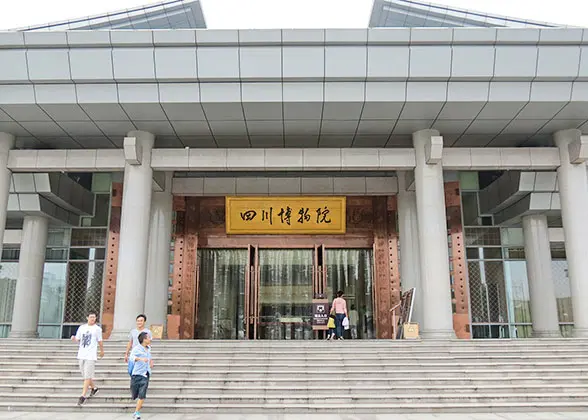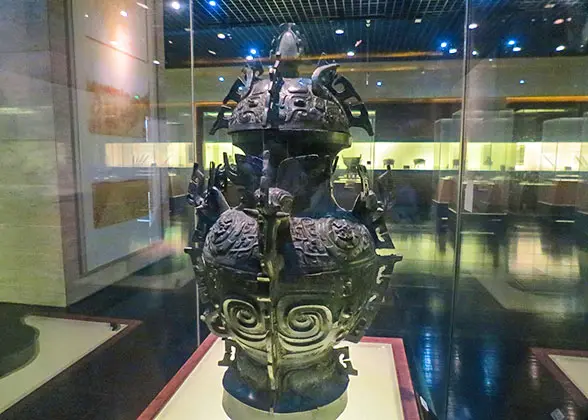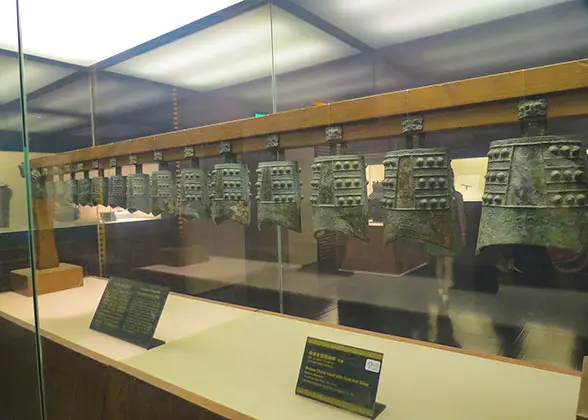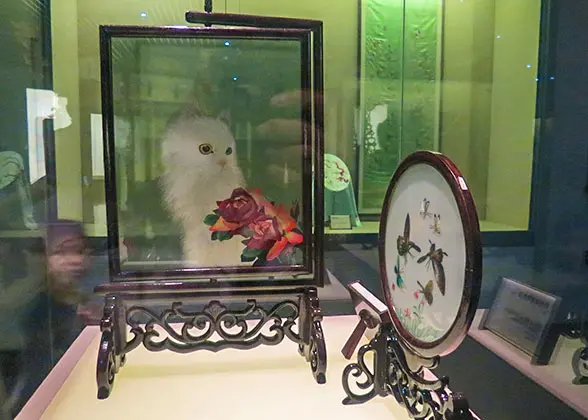Sichuan Museum
Sichuan Museum, adjacent to Huanhua Stream Park in the west of Chengdu city, is the largest comprehensive museum in southwestern China. Sichuan, rich in natural resources and strong culture, is reputed to be the 'The Land of Abundance'. Thus, a range of the province's historical collections can be found in the museum.
The Sichuan Museum covers an area of 12,900 square meters (15,400 square yards) with 14 exhibition halls and hosts various unique exhibits. The collections feature 260,000 items, which places it sixth in China proper. The rare historical relics number no less than 60,000, of which more than 1,399 are unrivaled. These have assured its importance among public museums across the whole country.
The cultural relics of Sichuan Museum are generally categorized into ceramics, stone sculpture, bronze wares, pottery, ancient coins, calligraphy and paintings, folk art and crafts, stone inscription and modern works of art. All of these collections bear various stories relevant to strong Shu-Han (221 - 263AD) overtones. Collections from the skull of Ziyang Man (3000 BC) to the paintings and artworks of the famous contemporary artists can cater to the interests of most visitors. Meanwhile, Sichuan Museum is also a good place for those who want to research the local history. The three-floor museum hosts a dozen galleries, and each gallery accommodates an abundance of items on display.
The first floor of Sichuan Museum features the typical characteristics of Shu-Han Culture and exhibits of pottery dating back to Han Dynasty. Tourists can enjoy the quaint stone inscription and pottery art, which reflect the creativity of local people of the periods.
The second floor mainly displays bronze wares of Ba and Shu States, paintings and calligraphy, and fine ceramics. The Chang Dai-Chien Art Center is full of amazing paintings, which is a must see for visitors to the museum. Chang Dai-Chien (1899 - 1983AD), a painting master of Sichuan, is one of the most famous Chinese artists of the 20th century. Many of his vivid forging works of the Buddhist frescos of Dunhuang Mogao Grottoes can be seen in this hall.
The third floor of Sichuan Museum exhibits vary from Tibetan Buddhist Relics, Wanfo Temple Stone Sculpture Center, Cultural Relics of Sichuan Ethnic, to Folk Art and Crafts. The Folk Art and Crafts Hall displays crafts made by the local ethnic minorities, such as necklace, clothing, musical instruments, and everyday objects utilized by the Qiang, Yi, and Tujia people. Most of those items on display pay special attention to the local tradition and custom, which allow tourists to glimpse at the daily life of Sichuan people and their society.
The exhibition halls are equipped with multimedia display devices. Besides, Sichuan museum offers the cross-cultural exchange center and multifunctional academic hall, which provides a platform for the academic research and cultural exchanges. By Metro: Take Metro Line 2 or Line 4 to get to Chengdu University of TCM & Provincial People's Hospital Station, Exit A. Then walk southwest around one kilometer to find the museum.
By Bus: Take bus line 170 and get off at the South Huanhua Rd. Or take bus line 35, 58, 82, 151, 165 and get off at Songxianqiao.
Chengdu Bus / Metro Search
 Nearby Attractions:
Nearby Attractions:
Thatched Cottage of Du Fu: The residence of the famous Chinese poet Du Fu (712-770AD)
 Top 10 Things to Do in Chengdu
Top 10 Things to Do in Chengdu
The Sichuan Museum covers an area of 12,900 square meters (15,400 square yards) with 14 exhibition halls and hosts various unique exhibits. The collections feature 260,000 items, which places it sixth in China proper. The rare historical relics number no less than 60,000, of which more than 1,399 are unrivaled. These have assured its importance among public museums across the whole country.
|
|
The cultural relics of Sichuan Museum are generally categorized into ceramics, stone sculpture, bronze wares, pottery, ancient coins, calligraphy and paintings, folk art and crafts, stone inscription and modern works of art. All of these collections bear various stories relevant to strong Shu-Han (221 - 263AD) overtones. Collections from the skull of Ziyang Man (3000 BC) to the paintings and artworks of the famous contemporary artists can cater to the interests of most visitors. Meanwhile, Sichuan Museum is also a good place for those who want to research the local history.
Layout
| 1F | Exhibits of Pottery of Han Dynasty (202 BC - 220 AD); Multifunctional Reception Hall |
| 2F | Bronze Wares of Ba and Shu States(original name of Sichuan); Paintings and Calligraphy Hall; Fine Ceramics Hall; Chang Dai-Chien Art Center |
| 3F | Tibetan Buddhist Relics; Wanfo Temple Stone Sculpture Center; Cultural Relics of Sichuan Ethnic; Folk Art and Crafts |
Exhibition Halls
The second floor mainly displays bronze wares of Ba and Shu States, paintings and calligraphy, and fine ceramics. The Chang Dai-Chien Art Center is full of amazing paintings, which is a must see for visitors to the museum. Chang Dai-Chien (1899 - 1983AD), a painting master of Sichuan, is one of the most famous Chinese artists of the 20th century. Many of his vivid forging works of the Buddhist frescos of Dunhuang Mogao Grottoes can be seen in this hall.
|
|
The third floor of Sichuan Museum exhibits vary from Tibetan Buddhist Relics, Wanfo Temple Stone Sculpture Center, Cultural Relics of Sichuan Ethnic, to Folk Art and Crafts. The Folk Art and Crafts Hall displays crafts made by the local ethnic minorities, such as necklace, clothing, musical instruments, and everyday objects utilized by the Qiang, Yi, and Tujia people. Most of those items on display pay special attention to the local tradition and custom, which allow tourists to glimpse at the daily life of Sichuan people and their society.
The exhibition halls are equipped with multimedia display devices. Besides, Sichuan museum offers the cross-cultural exchange center and multifunctional academic hall, which provides a platform for the academic research and cultural exchanges.
How to get to Sichuan Museum
By Bus: Take bus line 170 and get off at the South Huanhua Rd. Or take bus line 35, 58, 82, 151, 165 and get off at Songxianqiao.
Chengdu Bus / Metro Search
| Entrance Fee | Free. |
|---|---|
| Opening Hours | 9:00 - 17:00 (stop admission at 16:00) Closed on Monday. |
Thatched Cottage of Du Fu: The residence of the famous Chinese poet Du Fu (712-770AD)
- Last updated on Aug. 14, 2025 by Demi Li -



